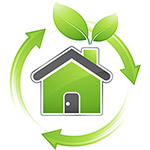Buildings are energy hogs, consuming more than 40 percent of all energy in the United States. While new buildings may be constructed with sustainability in mind, older buildings must undergo extensive renovations to become more energy efficient.

While many of these renovations and upgrades have been successful in reducing or stabilizing energy use, they often do not consider the comfort of the occupants.
A team of researchers, led by Arye Nehorai, PhD, the Eugene and Martha Lohman Professor of Electrical Engineering and chair of the Department of Electrical & Systems Engineering, has received a one-year grant from Washington University’s International Center for Advanced Renewable Energy & Sustainability (I-CARES) to take an interdisciplinary, “human-centered” approach to making buildings more energy efficient.
Co-investigators include Chenyang Lu, PhD, professor of computer science & engineering; Don Koster, senior lecturer in the Sam Fox School; and Bill Drake, strategic technology manager for Emerson Climate Technologies.
The team will work with Washington University Quadrangle Housing’s Green Rehab project, an effort to retrofit 1920s apartment buildings originally built for families into more energy efficient and useful space for the undergraduate and graduate students who now live there.
The Green Rehab project is comparing buildings renovated using standard construction practices and mechanical systems with those designed and using more sustainable materials and procedures.
“Our ultimate goal is to develop an automation system that will give recommendations to the residents of the apartments about how to use their appliances at different times to have the best tradeoff among their comfort, energy savings and reduction of emissions,” Nehorai said. “In the long term, we will design local hourly pricing schemes so we can be specific in our recommendations on using energy at the best times of the day.”
To learn about the comfort of the residents and their preferences, the team will conduct surveys to learn about their behavior in using appliances and how tolerant they are of changes in the environment, such as heating and cooling, Nehorai said.
Lu, an expert in wireless sensor networks, will develop and install a wireless monitoring and control system throughout one of the buildings, known as a test bed, that will report real-time data on how residents use their heating, ventilating and air-conditioning systems or household appliances, such as washers, dryers and dishwashers, at different times of the day.
Using algorithms formulated by Nehorai, building residents will be notified via a Smartphone app the team will develop about how they could use their appliances more efficiently. For example, if a resident wants to use the dishwasher at 3 p.m. on a 95-degree day, the system can send a message telling them that if they waited, they would save both energy and money.
Unique to this project is the “human-centered” approach, Nehorai said.
“Students can use the appliances anytime they like,” he said. “But we want to show that those in the experimental building will save money and still feel they didn’t sacrifice too much in terms of comfort and convenience compared with those in the other building.”
In addition, the team will evaluate the benefits that could be seen from using renewable energy, such as rooftop wind turbines and solar panels, and calculate any energy savings from changing to those sources from electricity during peak times.
Students living in the apartment are encouraged to initiate research projects of their own based on the system, Nehorai said.
________________________________________________
The School of Engineering & Applied Science at Washington University in St. Louis focuses intellectual efforts through a new convergence paradigm and builds on strengths, particularly as applied to medicine and health, energy and environment, entrepreneurship and security. With 82 tenured/tenure-track and 40 additional full-time faculty, 1,300 undergraduate students, 700 graduate students and more than 23,000 alumni, we are working to leverage our partnerships with academic and industry partners — across disciplines and across the world — to contribute to solving the greatest global challenges of the 21st century.